If you believe the stories told about it, the iRacing IndyCar community is the home of tribalistic teams, hyper-protected setups and attempts to steal them anyway, and drama playing out both in the forums and on the track.
From the outside, it’s enough to make even an experienced driver think twice before stepping into the series.
But what about an IndyCar rookie? A complete outsider? Someone who first drove the car only… say… 60 hours before their first race?
That’s the position I was in last week as I had less than three days to learn, master, and race the Dallara IR18 IndyCar.
My lack of experience in the car was due to one part apathy and one part purposeful planning. As a GT driver, high-level open-wheeled cars rarely make the top of my list for cars I want to drive, so when the new-for-2018 IndyCar was released earlier this year, I wasn’t too desperate to get behind the wheel.
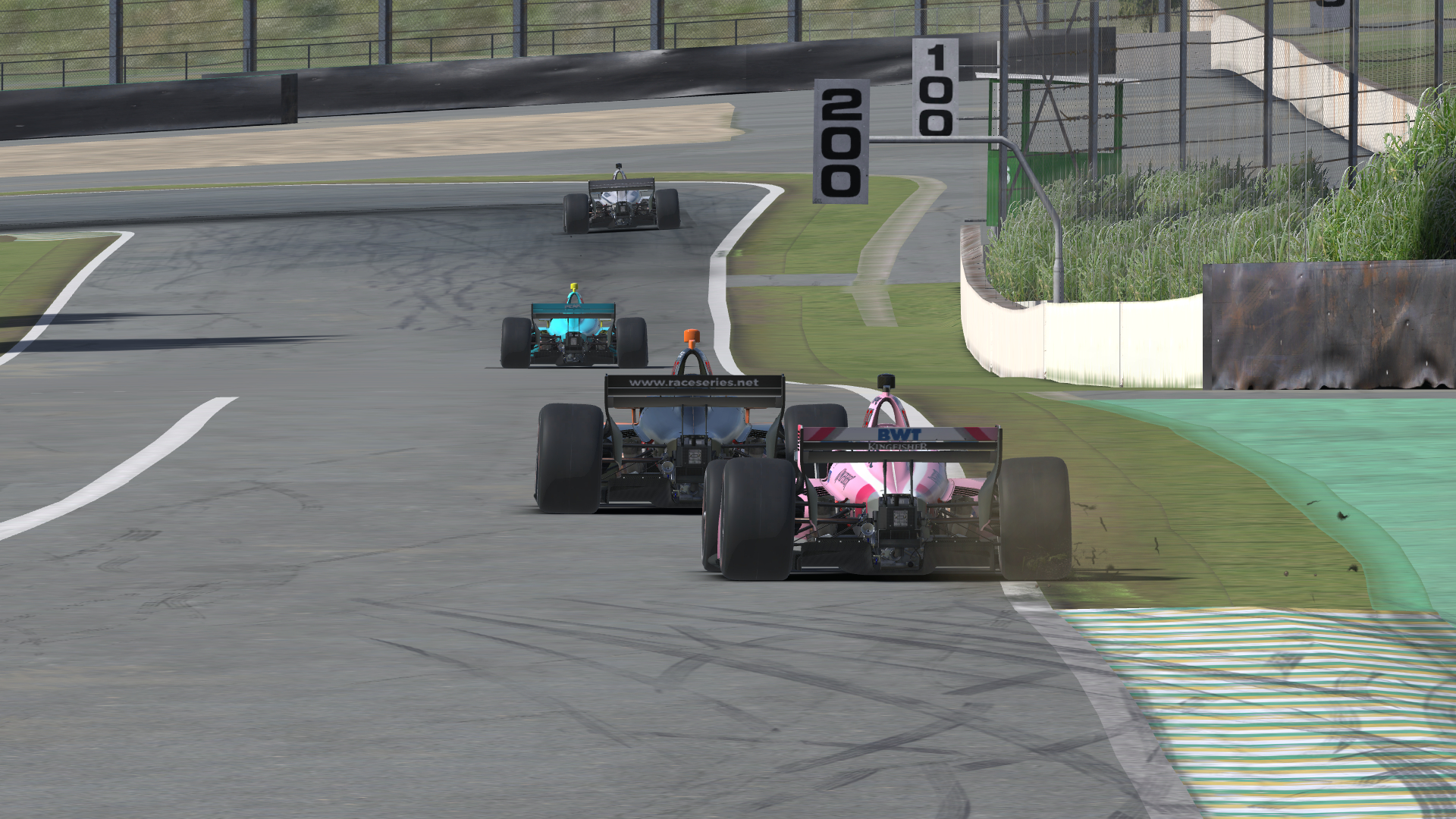
A bit of foreshadowing of my close on-track battle this week.
At that point, this Summer Road Trip was already in the planning stages, and since I didn’t drive the IndyCar last summer, I knew it would be one of my targets this year. It would make for an interesting story, I thought, if I gave myself only a few days to get up to speed.
So aside from loading up a test session with the car to make sure my paint scheme looked okay, I never fired up the car and took to the track until the Saturday before the start of the race week.
The IndyCar Road series on iRacing is unique in a few ways beyond even its scurrilous reputation. For one, it’s only partially a road series. Half of the weeks this season were oval races, mimicking the real-life IndyCar series’ diverse schedule.
In addition, while many high-level series hold their most populated races over the weekend, giving drivers all week to practice, the IndyCar community has chosen to make the very first time slot of the week — Monday night at 8 pm EDT — their strength-of-field race, and sometimes the only one with multiple splits.
That would make my task even more difficult since I would have less time to get up to speed around Interlagos — a track where I’d need to harness both the car’s aerodynamics in some of the fast, sweeping corners, as well as its mechanical grip in the slow infield section.
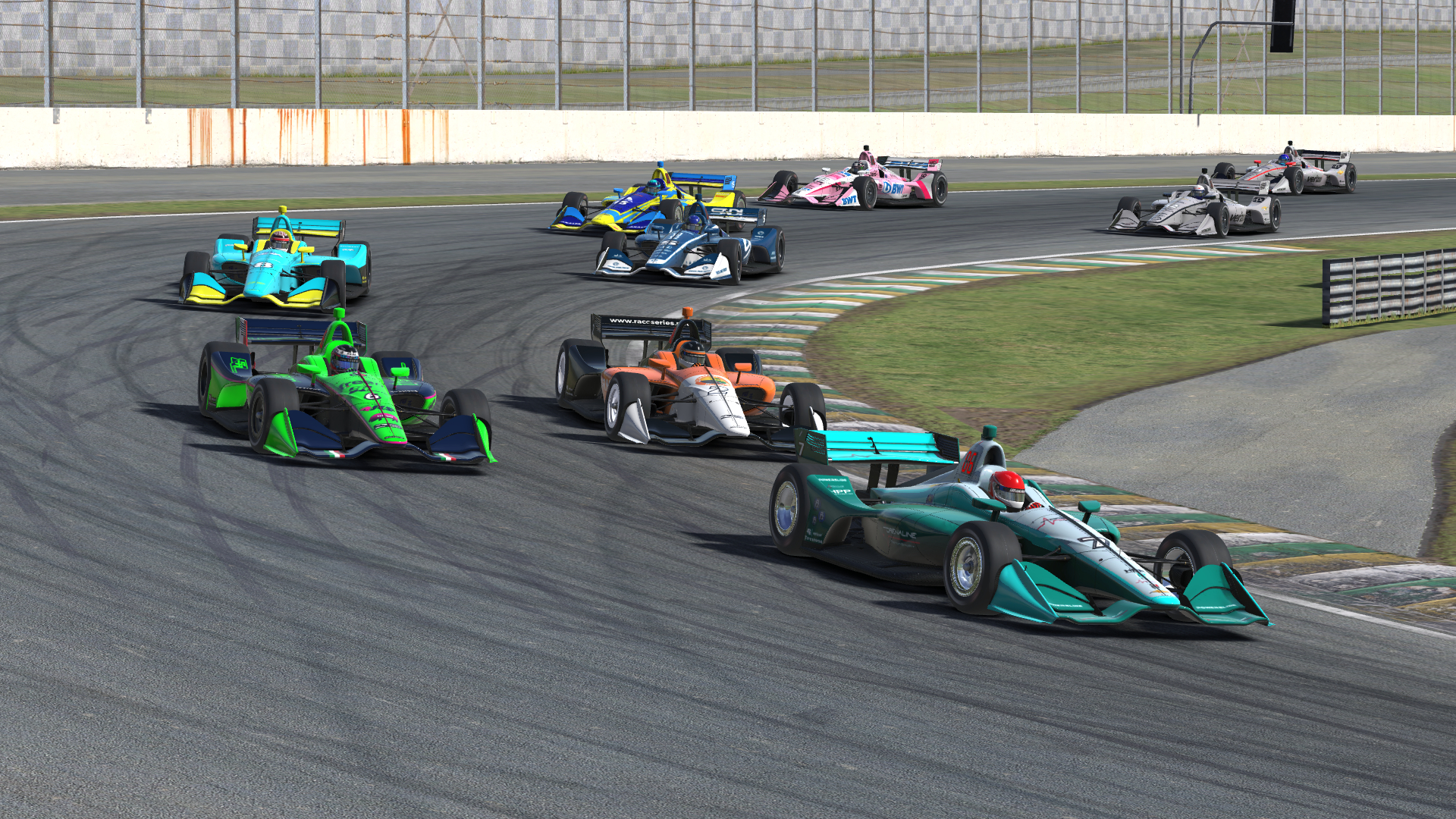
A field of IndyCars streams through turn 3 at Interlagos.
Feels Like the First Time
It wasn’t a challenge I took lightly, especially considering my limited experiences with past versions of the IndyCar on iRacing. In my only attempt to drive the original Dallara on a road course, I found myself several seconds off pace in practice at Silverstone, which was enough to discourage me from racing the car that week or ever again.
In its replacement car, the DW12, I earned one of my most proud oval wins in the second split of the Indy 500, but I never quite got the hang of it on a road course, so I was truly a one-and-done driver in that car.
After getting behind the wheel of the IR18 on Saturday morning, my first practice run started surprisingly well. I didn’t have trouble keeping the car on track or fighting a lack of grip on corner exit. In fact, almost immediately I was able to log some consistent lap times that were within two seconds of what the fast guys were running.
As my first run continued, though, I noticed that I was locking up the front tires entering many of the slower corners. Later in the run, that condition only got worse. Eventually, the front grip had so severely eroded — just 45% tread remaining on the inside of the left front tire — that the car wasn’t drivable anymore and I nosed into a wall after about 15 laps.
Going that far before crashing was a decent way to start, but also not the most ideal way to finish. With mixed feelings about my first practice laps, I left the car in the garage for the rest of the day on Saturday, the hours until the race ticking down all the while.
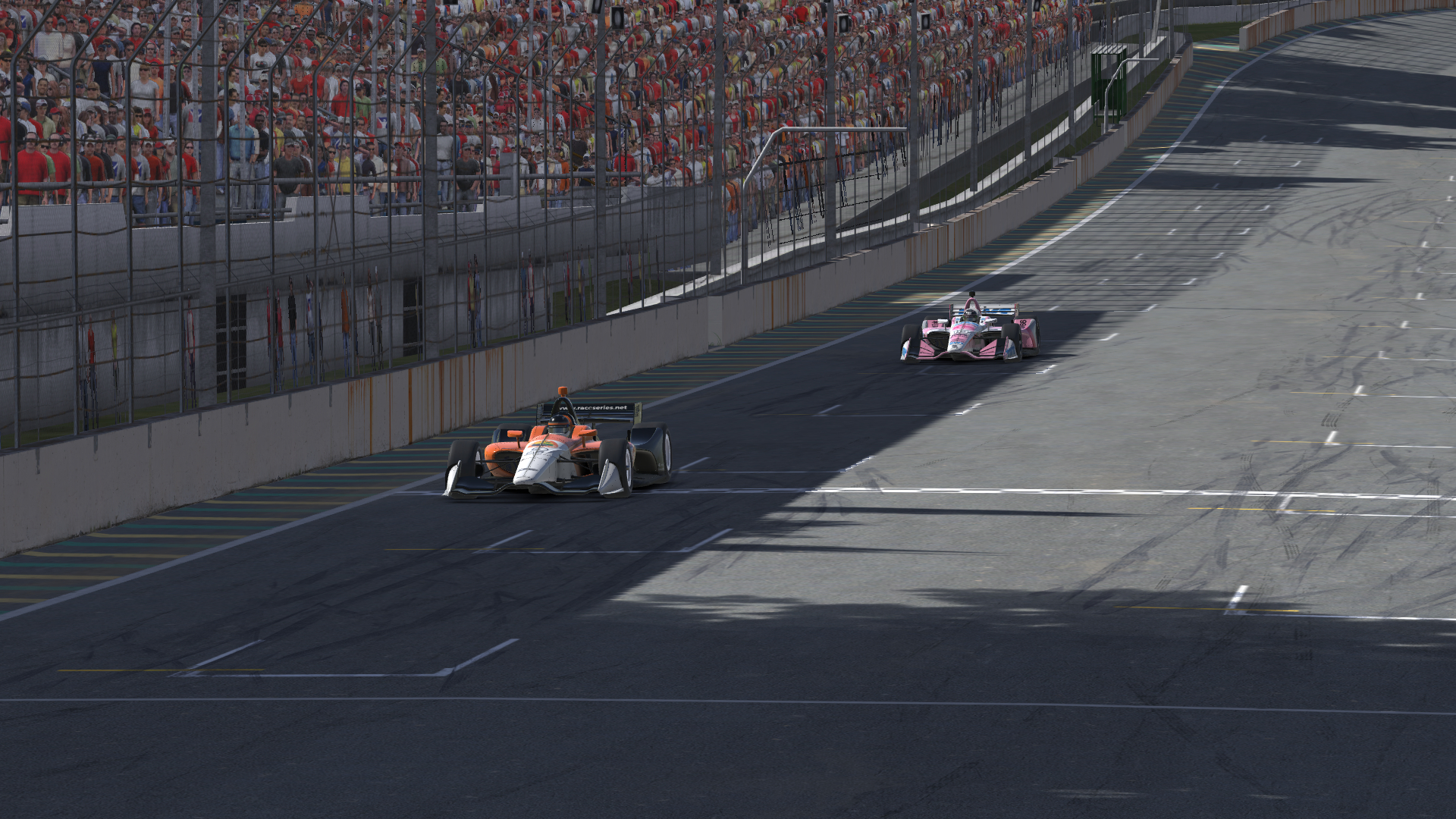
Flying down the high-speed frontstretch.
For my second day of practice on Sunday, my goals were to find more speed and to record at least one full fuel run while working on my tire management.
I tried a few different setups and found one from Virtual Racing School that was both fast and stable. While the IndyCar garage can be intimidating for someone not well-versed in the wings and things on open-wheelers, I knew enough about settings such as anti-roll bars and ballast to tweak the setup to my liking.
The improvements came almost immediately. I managed to gain nearly a full second compared to my previous best lap time, and over a full run, I was at least half a second per lap faster with less fall-off toward the end.
Since there wouldn’t be any official practice sessions before the race, I hopped into a hosted practice later that night to get some experience in different weather conditions and to see how I stacked up against other drivers. I did better about locking up the tires and after a full fuel run, my worst tread wear reading was 62%.
It was tough to say exactly how my times stood up since I wasn’t sure whose laps might have come on a faster track, with qualifying fuel, or using the push to pass button — and IndyCar-exclusive feature that grants a brief burst of extra horsepower. But with race fuel in the car, I was just two tenths off the fastest driver when I finished my practice laps.
Woeful Warmup
Comfortable with my pace and consistency, I figured I could do a couple hours of practice on Monday night and be ready for the race.
It turned out to be the most frantic, and at times frustrating, two hours of my entire Summer Road Trip so far.
On Monday afternoon, I downloaded a new setup shared on the forums that had a different, higher-downforce front wing configuration. After copying those settings to my existing setup, I ripped off a lap three tenths quicker than anything I’d run so far.
However, those changes shifted the balance of the car toward oversteer and made it almost impossible to control after a few laps. Any adjustments I tried either didn’t fix the handling or slowed me down.
Then I checked the clock. Just one hour to go until the race…
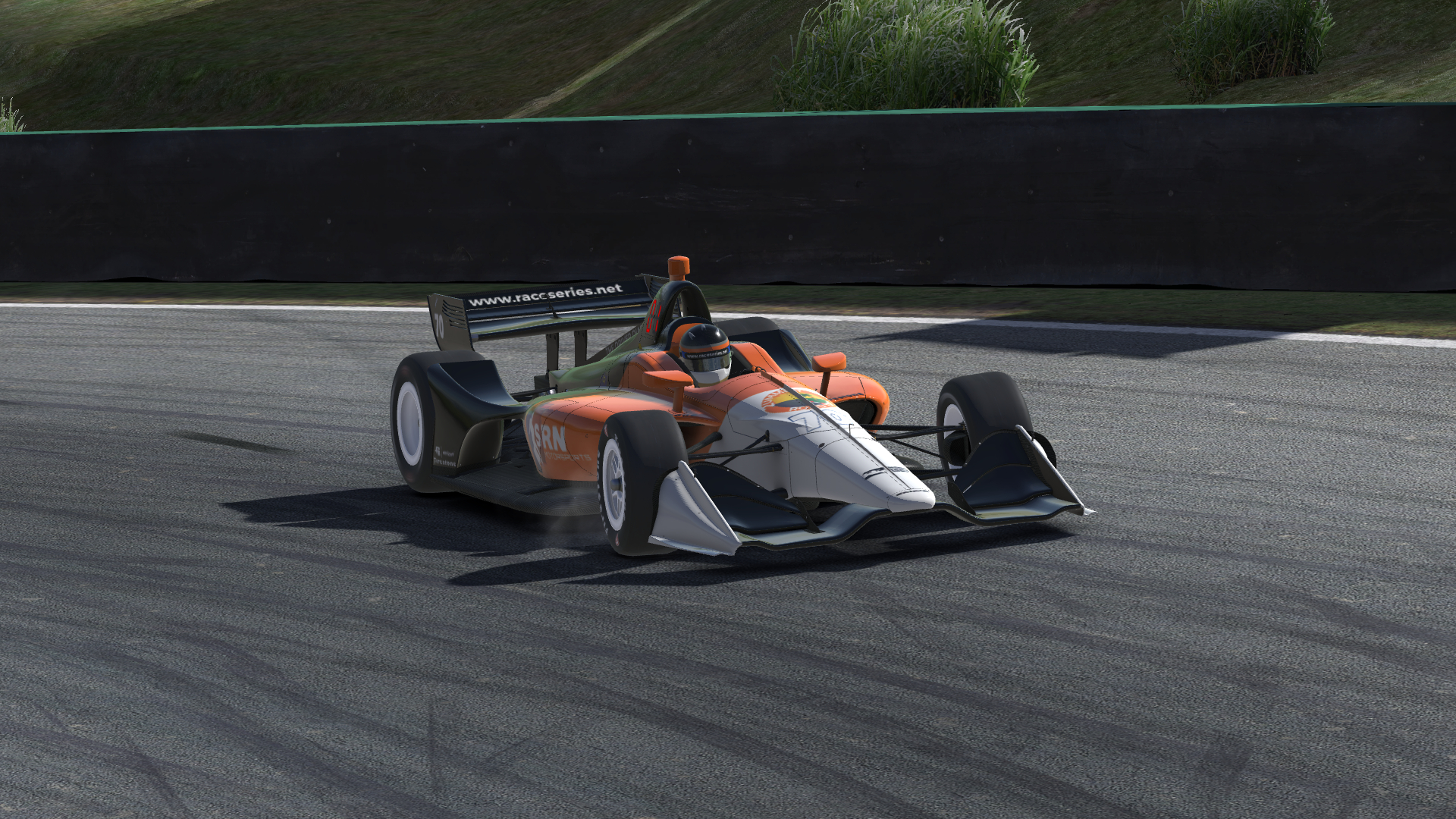
Locking up the right-front tire under braking.
I reverted to my tried-and-true setup and suddenly couldn’t find speed with it either. On the IndyCar’s steering wheel display, I noticed that I was losing several tenths of a second through the infield. The other setup’s extra front downforce was clearly helping me there.
Thirty minutes to go…
After running laps with both setups, I compromised and went with a hybrid. I stuck with my original setup but added a body wicker to provide some extra downforce without throwing off the balance too much.
After a few differential changes to remove some oversteer on corner exit, I was satisfied with the adjustments, but still worried that if the track was hot and slick in the race, I might wish I’d gone with an even higher-downforce option.
There was no time for any more major adjustments, though. The clock was running out on my limited practice and the race session was starting.
A Promising Start
True to my fears, the race session’s weather and track conditions were the hottest I’d seen all week. It was too late to experiment with adding downforce, especially since the only higher-downforce setup I’d tried would likely be even more uncontrollable in these conditions, so I stuck with what I had and hoped for a little beginner’s luck behind the wheel.
As the #2 car in the highest of two splits, I knew I probably wouldn’t be able to perform as well as my iRating suggested. In qualifying, I only wanted to end up in the top half of the field. And I did, but just barely. I started eighth out of 17 cars on the grid.
From there, I figured a top-five finish might be within reach, but only if I could keep the car on track and pointed straight. Of course, that job would also be a bit tougher with clear skies and a warm track.
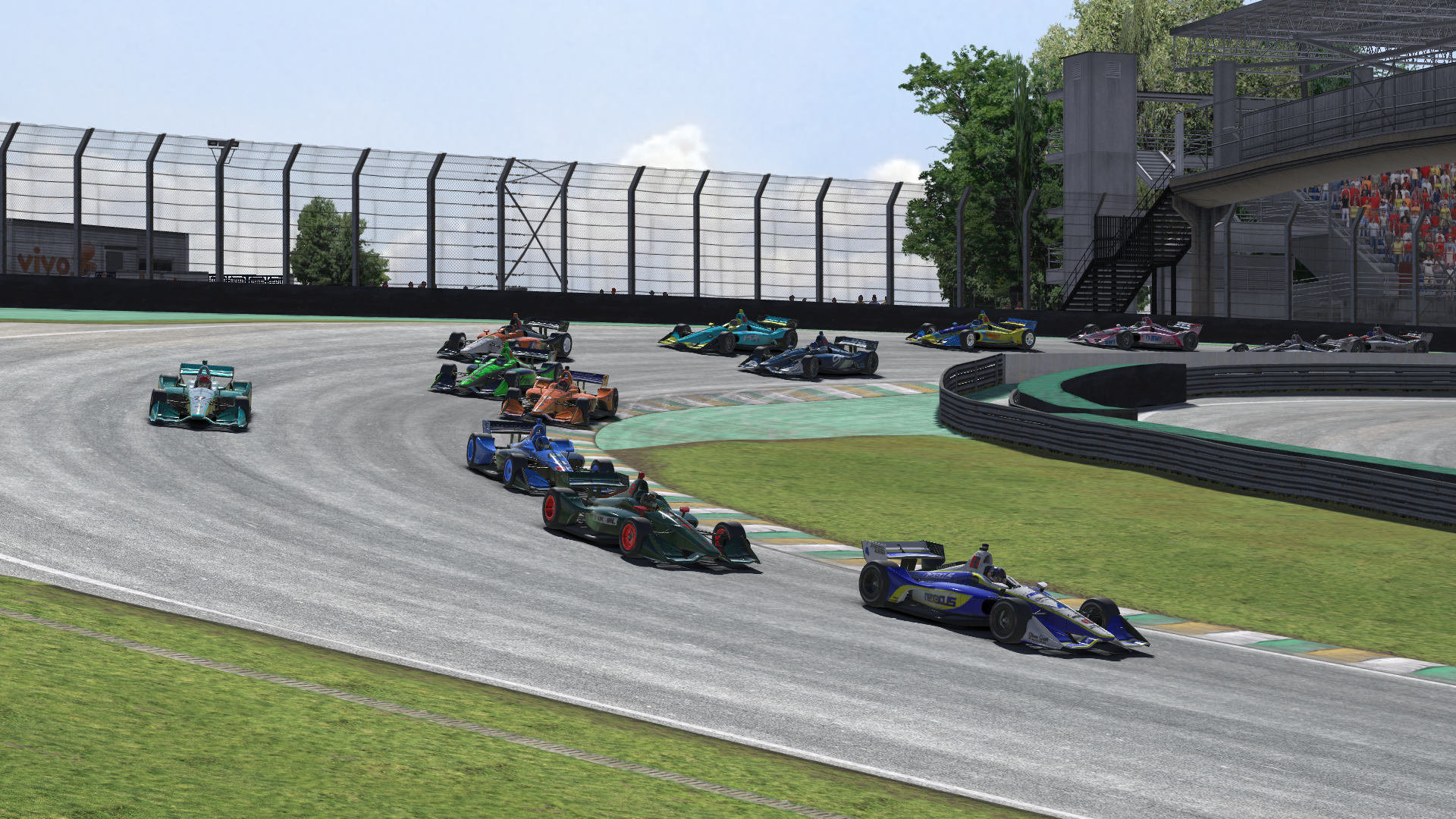
The field heads through turn 1 at the start of the race.
On the rolling start, I got a good run down the front stretch and gained two positions entering the always-tricky Senna S. On the run to turn 3, though, I lost a spot to a car using his push to pass, and later that lap, I lost another one for the same reason.
I could have been on the button both times to defend my position, but I told myself entering the race that I would save my 10 push-to-pass uses until later on. In my mind, the running order is generally more fluid early in the race, so it seems wasteful to use a limited resource on a position I might have picked up anyway.
It’s also a personal preference of mine. Whenever I’m watching real-world IndyCar series races, I find myself respecting and rooting for drivers who save their pushes-to-pass for the end. Perhaps that comes down to the hunter vs. hunted mentality. I’d always rather be the one doing the chasing instead of the one being chased down.
With those two positions lost, the next few laps were largely single-file in the front half of the field as everyone came to grips with the slick track. The first car to fall victim to the conditions was the race leader. On lap 4, he bobbled through turn 2, sliding into the path of the second-place car.
Suddenly, the two fastest drivers in the field were gone and my top-five dream was looking more and more likely. However, my first of two mistakes in the race would soon put it in jeopardy.
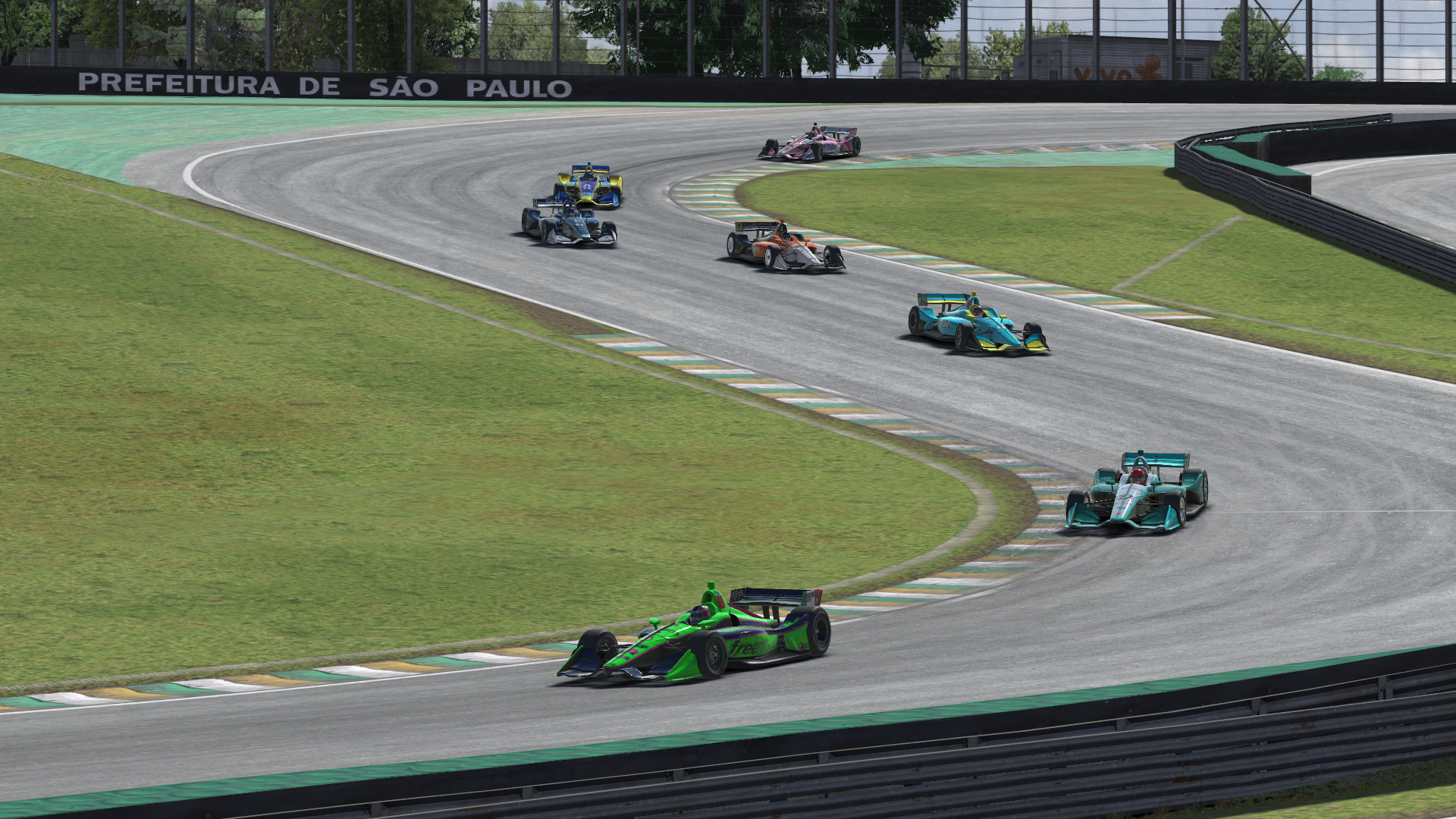
Single-file racing through the Senna S.
Backing Up
Near the end of lap 6, I was right under the wing of another car through the infield section and planning to make a pass attempt — including my potential first use of the push-to-pass button — on the main straightaway.
In my eagerness, I got back to the throttle a split-second too soon exiting the second hairpin and the car lost traction, sliding onto the grass. It cost me four positions and nearly eight seconds, but thankfully, I hadn’t nosed into the wall. The car was as good as new, aside from some extra stress on the tires.
It was a small setback for sure, but as I started closing the gaps to the cars ahead, I knew I could retake those positions. That was, at least, until my second mistake in the span of just six laps cost me everything I’d regained and then some.
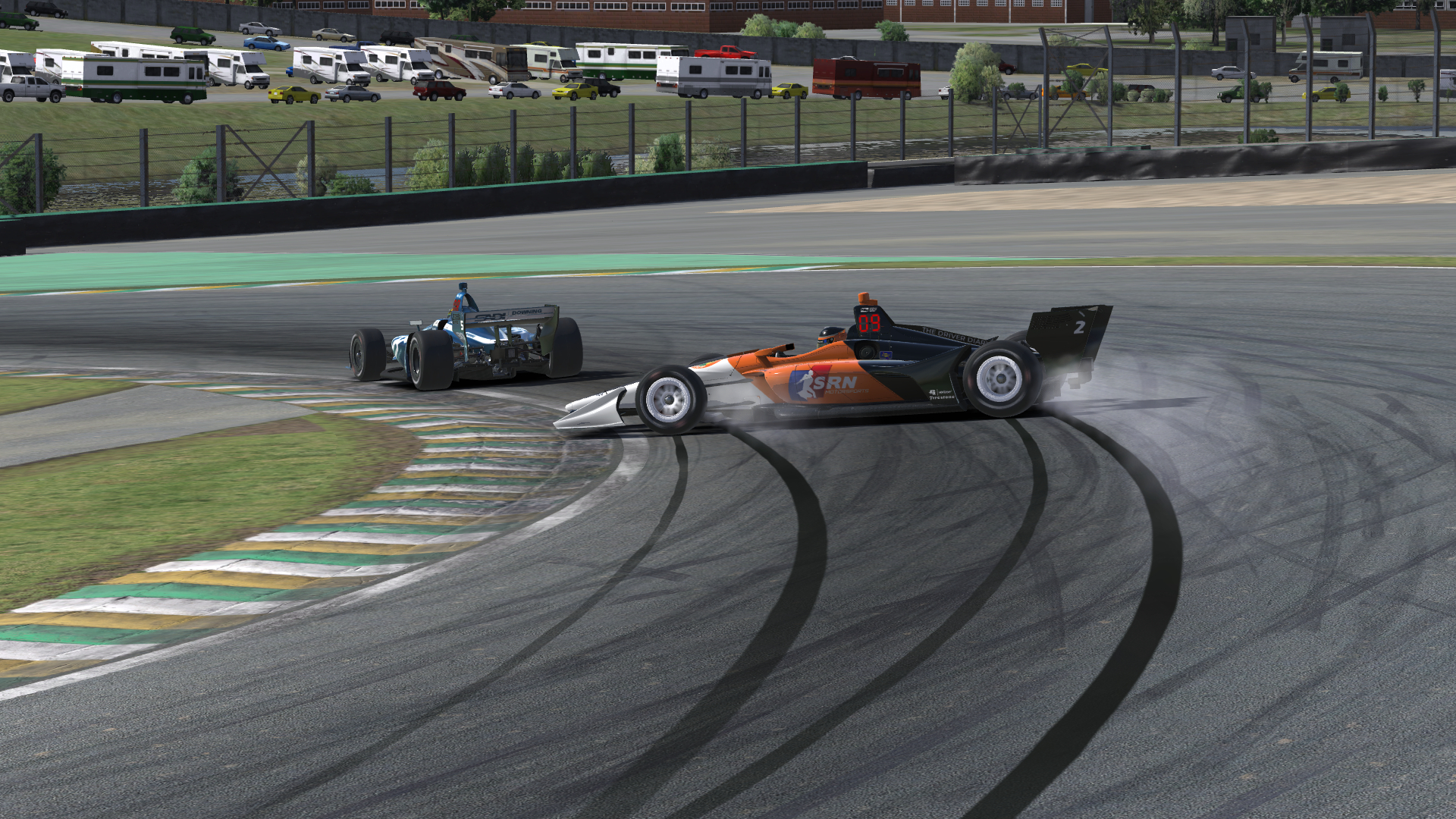
Letting the car — and any time gained on the cars ahead — slip away.
Entering turn 3, I was right behind another car but not quite close enough to make a pass attempt. He braked earlier than I anticipated, and in a panic, I locked the tires and sent the car for a half-spin sideways.
Once again, I managed not to damage the car, but losing seven more seconds and dropping to a distant ninth place certainly damaged any confidence I had built so far.
I could at least tell that by that point in the run, I wasn’t the only one struggling. Two laps later, the sixth-place driver spun all by herself and rejoined right ahead of me. However, it seemed to be a one-off error, as she drove away from me in the following few laps. I wasn’t sure whether she was using her pushes-to-pass or was simply faster on old tires, but either way, it seemed like she was uncatchable.
Down the Stretch
I entered the only round of pit stops needing some help over the final 15 laps to gain any positions. The first of that help came from afar when the then-second place driver crashed out. I gained another spot by virtue of a faster and earlier pit stop than the driver who had spun ahead of me a few laps earlier.
That quick stop also helped me close in on the same car I’d spun behind under braking earlier in the race. Determined not to let history repeat itself, I used my push-to-pass exiting turn 2, and although he took a defensive line, I found room to his inside and completed the pass entering turn 3.
After that, I was catching the fifth-place driver, who was the same one that was two tenths quicker than me in the Sunday night hosted practice session. This time, though, I seemed to have the advantage, sometimes by up to a second per lap. I used several pushes-to-pass to get within drafting range, and on lap 30, I passed him down the frontstretch.
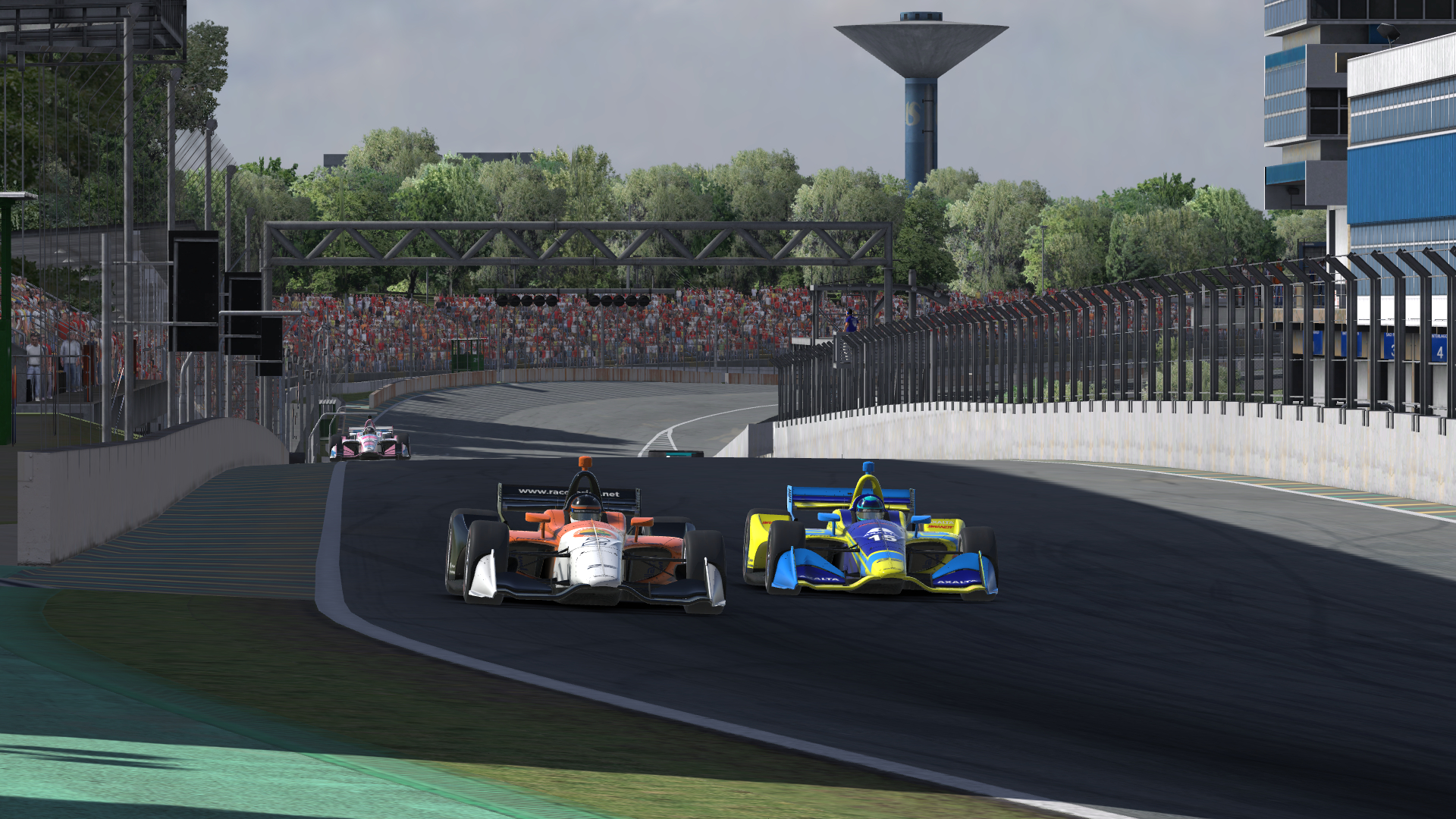
Making the pass for fifth place around the outside entering turn 1.
With five laps to go, I had four button pushes left in the bank, so I could use one almost every lap — exactly what I’d hoped for when I was so stingy with them early in the race. However, my plan to be the hunter wasn’t exactly taking shape. The fourth-place car was too far up the road for me to catch, and my mirror was becoming full with the same driver who was faster than me on older tires in the race’s first run.
With three laps — and three pushes-to-pass — remaining, she was within a second. The next lap, the gap was down to a half second, forcing me to take a defensive line into turn 3.
Although her pace advantage was clear, I knew that barring a mistake in the infield, she probably couldn’t pass me there. That meant I just needed to get a good run off the final corner and deploy my push-to-pass for the final few laps.
Despite my ragged tires and nearly running wide entering turn 1 with two laps to go, the extra horsepower down the straightaway proved to be enough, and I was able to hold onto the position. It may not have been my best finish of the season, but I’m pretty sure it’s the hardest-fought fifth-place finish I’ve ever had.
IndyCar Series - Race
Monday, August 6 at 8:00 pm EDT • Strength of Field: 3293
Finish Start Interval Laps Led Fastest Lap Incidents Points iRating Safety Rating
5 8 -32.297 sec. 0 1:17.077 4 145 5170 (+6) A 4.92 (+0.02)
Series Status
Despite my decent finish, I certainly don’t consider it proof that I’ve mastered the IndyCar. Nearly spinning twice and underperforming compared to my iRating isn’t exactly the mark of perfect execution.
But considering I had put in less than three days’ effort in this car and was competing against drivers who race it week in and week out, it wasn’t such a bad result, especially in coming out on top of a close battle by managing one of this car’s more unique strategic elements.
Setting aside my two costly mistakes in the race, I still couldn’t shake the feeling that this car isn’t as tough to drive than its predecessors. I consulted with my teammate Dean Moll, who has driven thousands of laps between all three of iRacing’s IndyCars, and he confirmed that the IR18 is indeed a bit easier to drive than the DW12, but for a nuanced reason.
“The biggest change is aero,” Dean told me. “In the real world, the IR18 moved downforce off the top of the body via less aero pieces, and therefore a larger percentage of the aero comes from the floor. This also resulted in a total downforce reduction.”
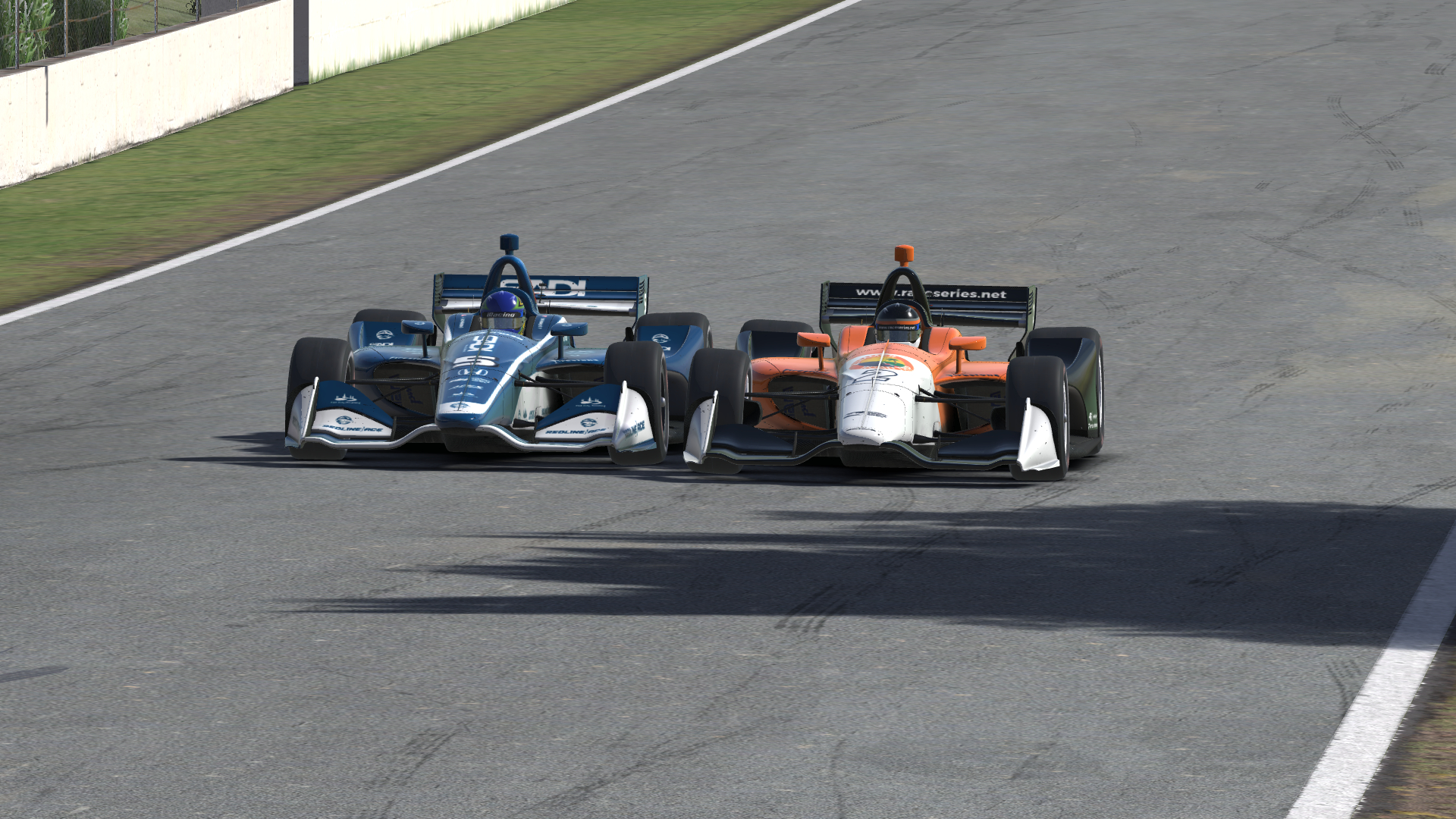
Close competition is easier in the IR18 thanks to its aerodynamic reconfiguration.
“In iRacing — and most people get this wrong — we actually have more total downforce than the DW12. It had the Dallara aero kit, which was used before the Honda and Chevrolet aero kits. Between more downforce and less aero push, you get closer racing.”
In other words, iRacing’s sometimes-frustrating failure to keep its cars as up-to-date as possible may have actually made our transition from the older DW12 to the IR18 even easier than for real-world drivers, who had several intervening years with higher-downforce manufacturer-created aero kits.
Even more surprising than the drivability of this IndyCar was the mood within the community, and how it was completely the opposite of what I anticipated. I came in expecting total tension and an unwelcoming atmosphere.
Instead, I found a forum with friendly conversation, at least one good road driver freely sharing his setups, and perhaps my first race of the summer with no frustrations aired over the radio — even when the leader spun and inadvertently took out the second-place car.
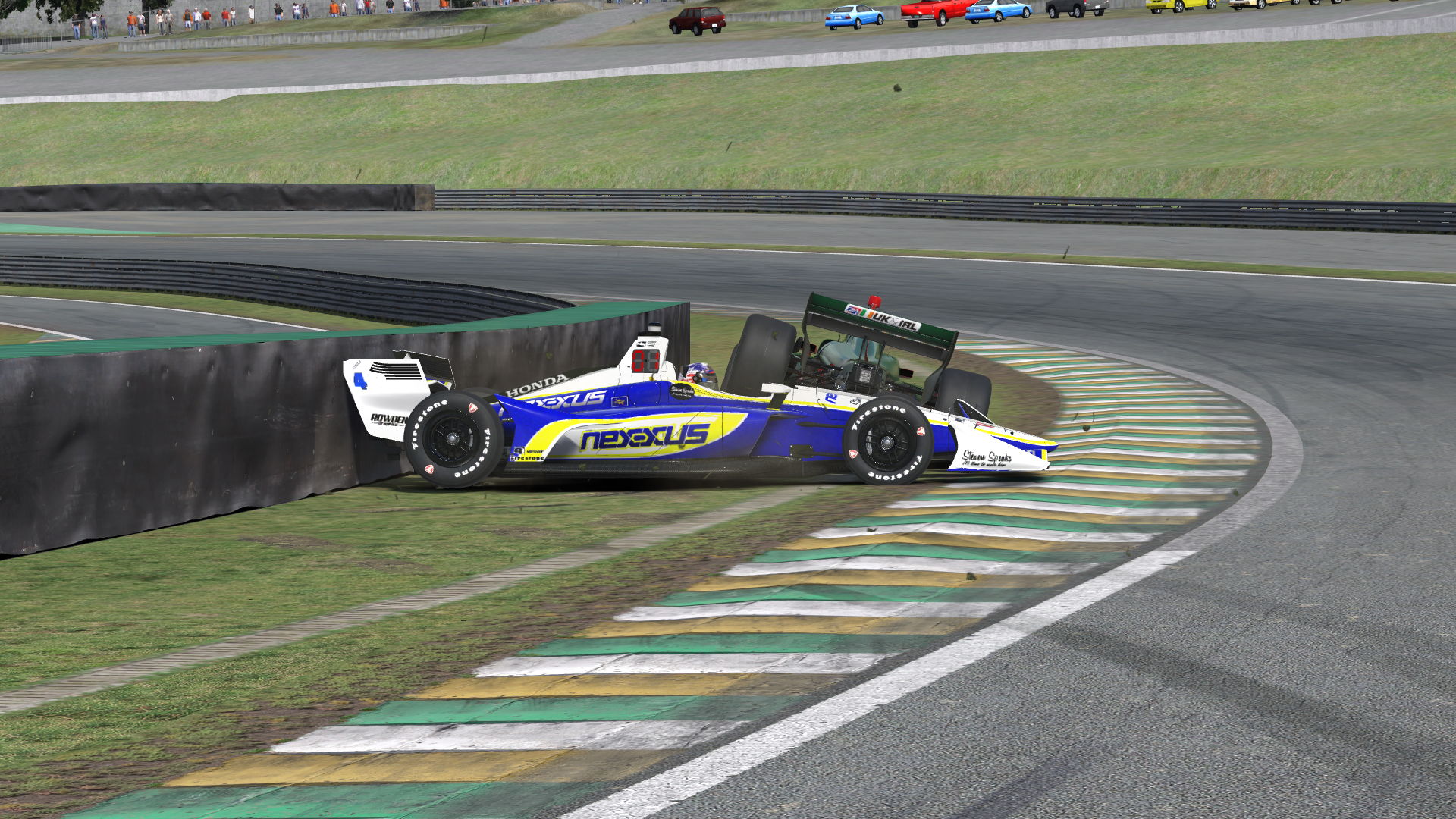
The two leaders crash together early in the race.
Dean said the road side of the IndyCar community tends to be more open anyway since it’s more dependent upon driver skill than secret setups. But he also admitted that even the oval side had lightened up, largely because one of the main points of contention within the community has now been settled.
“One of the big debates was a group of individuals wanting a 12-week open-setup oval series,” he said. “This put the road series as secondary and did not allow the mixed oval/road nature of the series to show. What we have now is probably best for overall participation.”
It was another unexpected discovery from my few days in the IndyCar, and one that opened my eyes — and possibly opened the door — to this somewhat hidden gem of a series.
After all the negativity I’d heard and the frustration I’d felt with its older cars, I can’t help but think that perhaps the IndyCar community on iRacing has turned a corner. And with the diverse combination of both ovals and road courses on the schedule, there are plenty of them for a driver to choose from.